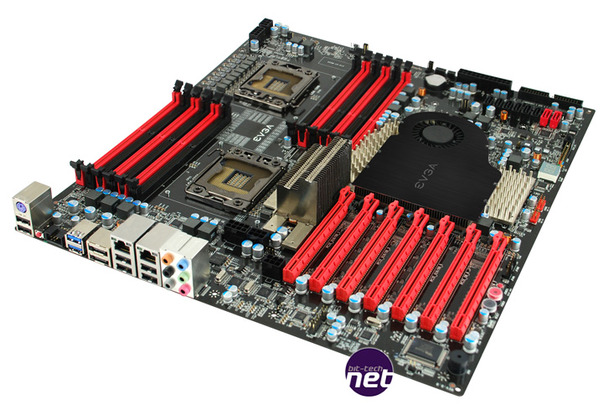
First Look: EVGA W555
Manufacturer: EVGAIt's been an awfully long time since we've seen or tested any EVGA products here at bit-tech, but late last year we were pleased to hear that the company had decided to put its PR house in order.
This article is the first result of that process, with the new PR team steadily drip feeding us information on what is shaping up to be one this year's most interesting products - the EVGA W555.
The W555 is a dual-processor LGA1366 motherboard with a difference - unlike existing traditional workstation/server motherboards - it's designed to be overclocked.
Created by a design team led by Peter 'Shamino' Tan, the W555 was first unveiled at the CES show a couple of weeks ago. However, the only shots we saw of the board were extremely blurry and covered with heatsinks. Fortunately, EVGA sent us these photos so we could take a closer look at how this monster motherboard is shaping up.
As you can see, the W555 isn't exactly small. As we haven't had a chance to play with a board yet, the exact dimensions are unknown, but EVGA has confirmed that it is larger than either the E-ATX or SSI standards. Then again, any motherboard with two LGA1366 processor sockets, 12 DDR3 DIMM slots and seven expansion card slots isn't ever going to be small.
As several eagle-eyed readers already spotted, the W555 has two LGA1366 processor sockets, however, that doesn't mean you'll be able to chuck in a pair of Core i7s and start overclocking. This is because Core i7s only have a single QPI link, which is used to talk to the motherboard X58 chipset. To run a pair of processors in SMP, you'll need a pair of Xeon W5000-series CPUs, each of which has a pair of QPI links, one to talk to the motherboard chipset, and one to talk to the other CPU.
The good news is that there is a whole range of Xeon W5000-series CPUs to choose from, but the bad news is that they're all considerably more expensive than the equivalent-frequency Core i7. That said, the prospect of being able to overclock a pair of 8-thread CPUs (four physical cores, four logical cores) is more than a little exciting for performance enthusiasts. What's more, you should be able to drop in a pair of Xeon-branded 12-thread Gulftown cored CPUs when they are launched later this year; that's 24 threads from one box if you're salivating so much you can't read your monitor anymore.
Each CPU socket is provided with its own bank of 6 DIMM sockets, just crying out for some high-speed triple channel DDR3. Generally speaking, Xeon 5500-systems are equipped with ECC registered DDR3, which although far less prone to errors than standard unbuffered DDR3, is a lot more expensive and is only available up to PC3-10600, i.e. 1,333MHz. However, the memory controller in the CPUs can support standard unbuffered DDR3 - something you'll almost certainly need to use for big overclocks.

MSI MPG Velox 100R Chassis Review
October 14 2021 | 15:04










Want to comment? Please log in.